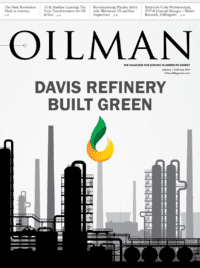As in many other energy sectors, the global demand for petrochemicals is increasing drastically. This demand is due, in large part, to the growing need for everyday products, such as plastics and petrochemical-derived fibers. A less-publicized development in the petrochemical industry is the burgeoning use of abundant – and currently very cheap – natural gas in the production of everything from liquid fuels to fertilizers. Multiply those widespread dependencies by the rapid rates of industrialization and middle-class consumption of goods in third-world countries, and the need for sufficient petrochemical stockpiles becomes dramatically apparent.
That, perhaps, is a masterpiece of an understatement. Because, while the IEA (International Energy Agency) has reported that petrochemical feedstocks currently account for 12 percent of global oil demand, the organization’s Future of Petrochemicals report predicts that, by 2030, petrochemicals will account for more than 30 percent of growth in world oil demand.
“Our economies are heavily dependent on petrochemicals, but the sector receives far less attention than it deserves,” said IEA Executive Director Dr. Fatih Birol. “Petrochemicals are one of the key blind spots in the global energy debate, especially given the influence they will exert on future energy trends. In fact, our analysis shows they will have a greater influence on the future of oil demand than cars, trucks and aviation.”
Need is One Challenge. Nature is Another.
Alongside all of these demand challenges is the ever-present, unpredictable forces of Mother Nature and the impact her whims can have on satisfying market needs. One of the biggest recent shocks to the petrochemical industry was Hurricane Harvey, which blew through Houston in 2017, knocking out more than half of U.S. production capacity for ethylene, a vital building block for basic plastics.
For months, American chemical producers were unable to fulfill orders for PVC, polyethylene and more, not only driving up the price of basic plastic materials, but also threatening the operation of companies that use polyethylene and other petrochemicals as feedstock. Instances such as this raise a two-part question for industry participants: how much backup supply should one keep on-hand to account for unforeseen disasters; and how does one properly account for said supply? When a business can answer these questions confidently, they will be better prepared to protect margins when disaster strikes.
Politics Also Plays a Part
The ever-evolving geopolitical landscape further fuels uncertainty. Threats of trade wars around the globe are always looming. The evolution and resolution of Brexit continues to impact world markets. Increasing threats of military war in the Middle East could generate a number of scenarios. The list goes on.
On the supply side, the recent threat of sanctions against Saudi Arabia from global economic leaders could prompt the country to reduce supply exports substantially, which could alter how the world receives and produces oil. Conversely, countries like Libya and Nigeria are planning on increasing their exports, and the potential emergence of new players with conventional sources of feedstock, such as Iraq and Iran, could shift the balance substantially. And while Venezuelan shale production continues to plummet, the U.S. has stepped up as a dominant force in that segment of the industry.
Supply and demand disruptions can lead not only to greater price volatility, but also the disruption of established value chains. Preempting those risks in real time is crucial, not only for producers, but also for portfolio managers and the investors they represent.
Everything Has Its Price
Petroleum-based feedstock prices are the major cost component for finished products. But another factor is also natural gas, which is the primary choice to power petrochemical energy plants. “Ethane, liquefied petroleum gases and naphtha pose a bigger threat to the refiners’ market share than electric vehicles and gas-powered transportation combined,” IEA representatives stated, estimating that refiners would see just 4.8 million bpd of the demand growth to 2023.
On the flip side, as the trend continues to convert more natural gas into liquefied natural gas (LNG) due to greater global demand, the constraints on the supply of natural gas will increase petrochemical production costs. Petrochemical feedstock managers will need to become more sophisticated feedstock buyers as they compete with LNG buyers for natural gas.
These combined forces – in addition to the aforementioned growing global demand, murky supply picture and the risk of unexpected natural disasters – have exposed a fatal weakness in the petrochemical industry: too many companies do not have the capabilities to manage their reserves in real-time or respond quickly when the market changes.
One must be able to gauge how much stock of each product to keep on hand, how to find alternate suppliers and transportation options, and even alternatives to the product they can use in the interim when volatility spikes. In order to respond to potential outages or supply/demand imbalances while also meeting contractual commitments, market participants – including those on the financial side of the equation – must have proper hedging and trading strategies to mitigate losses.
Offsetting Volatility with Visibility
The pre-2014 stable price environment lulled many chemical company leaders into a false sense of security. That year’s dramatic drop in oil prices was a wake-up call, but still, many companies continue to rely on dated, manual-process risk management systems. However, the problem is fixable.
While the market is complicated and ever-changing, what companies must do is control what they can and develop a strategy to cope with price fluctuations and the ups and downs connected to base products and feedstocks.
A petrochemical company with the right tools in place can expand margins in a falling-oil-price environment by identifying sourcing savings ahead of declines in product pricing. When oil and/or shale gas prices go back up, margins can still be protected. The key is to have risk and market condition visibility, as well as the ability to react to those changes in order to stay – not just one – but several steps ahead.
To deal effectively with increasing volatility, businesses require robust and flexible CTRM (Commodity Trading and Risk Management) software, coupled with advanced analytics, such as Allegro’s cloud-ready software, Allegro Horizon. This type of software provides petrochemical businesses with a flexible platform that enables real-time portfolio and risk management. Allegro’s system is capable of handling the complex, ever-changing and increasingly volatile world that petrochemical companies face today.
In the spirit of restating the obvious: there will always be volatility in the world’s energy markets. The question is, as the energy landscape continues to evolve, triggering market growth and – as a result – more risk, are petrochemical companies prepared to make the right business decisions?







